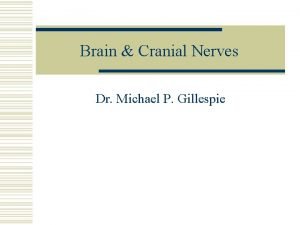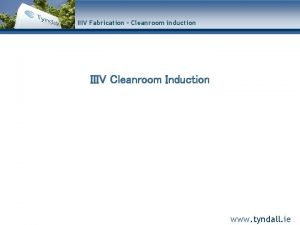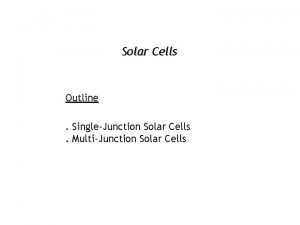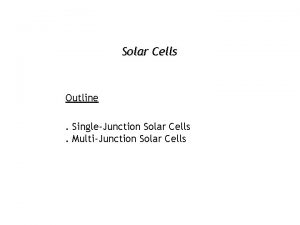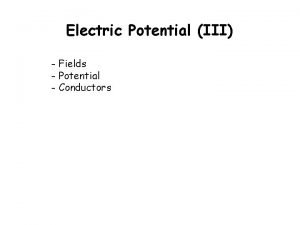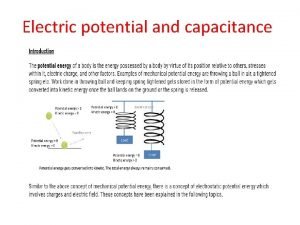The Challenge and Potential of IIIV Solar Cells















- Slides: 15

The Challenge and Potential of III-V Solar Cells Sarah Kurtz Gaute Otnes Thesis Defense March 16, 2018 Lund, Sweden

Overview • A little history: • R&D on thin-film III-V cells ~30 years ago • Success of single-crystal III-V cells • The challenge: Why is it so hard? • The opportunity: Why is it important? 2

In the 1970 s, the OPEC oil embargo motivated exploration of alternative energy!

Benefit of thin-film cells was quickly realized: less material, potentially lower cost Ruth and coworkers at Rockwell International showed that the material needed for a Ga. As cell would be much less than needed for silicon cell and estimated that the costs could be quite attractive Contract E(04 -3)-1202, Report SAN/1202 -77/3, Aug. 1977

So, thin-film Ga. As cell R&D was funded • In 1977, Murray, at JPL, started with goal of > 15% at $0. 50/W: • Steel substrates; recrystallization of germanium • Chemical vapor deposition of Ga. As & other low-cost processes • Smith, at Perkin-Elmer, undertook epitaxial Ga. As on Fe: • Grew Fe on Ga. As, but growth of Ga. As on Fe resulted in mixed phases • Epitaxial Ga. As could be grown on a layer of Sr. F 2 on Fe. • Yeh also undertook >15% thin-film Ga. As • Ga. As on Ge films on metal or silicon. • Achieved 9. 1% using bulk poly-Ge substrates • Achieved 19. 4% for Ga. As on Ga. As substrate • Chu, at Southern Methodist University reported 12% for Ga. As on Ge/Si • Additional work at Varian (OMCVD), Cornell (study of grain boundaries), Rensselaer Poly. (transport between grains), IBM…

A key conclusion - large grains are better

Single-crystal III-Vs have been more successful

Overview • A little history: • R&D on thin-film III-V cells ~30 years ago • Success of single-crystal III-V cells • The challenge: Why is it so hard? • The opportunity: Why is it important? 8

Recombination at surfaces Passivating window n-type p+ back-surface field Defects around the perimeter can decrease photovoltage

Surfaces are a source of defects Grain size of ~ 10 µm may be necessary to reach 20% for Ga. As (In. P is more forgiving) Ga. As Tendency to form defects & sensitivity to those defects reduces photovoltage of thinfilm III-V cells “It’s a challenge” Kurtz, et al 2008 https: //doi. org/10. 1063/1. 53447

Surfaces are a source of defects Nanowires increase the challenge of passivating the surface defects n i Nanowires would be p over here Ga. As Kurtz, et al 2008 https: //doi. org/10. 1063/1. 53447

Overview • A little history: • R&D on thin-film III-V cells ~30 years ago • Success of single-crystal III-V cells • The challenge: Why is it so hard? • The opportunity: Why is it important? 12

PV value depends on the level of penetration PV prices need to decrease to make room for cost of storage Denholm et al. 2008 Simulated Dispatch in California for a Spring Day with PV Penetration from 0 -10% 13

Another bit of history: Power. Guard. TM Roofing Tile announced 1994 First WCPEC (PVSC) 1994, p. 1004 “…the building integration reduces the cost of a Power. Guard. TM system by 14% to 26% rather than incurring a structural mounting cost of 18% to 22% to conventionally fasten the system. ” The vision is good! What went wrong? Could nanowire cells provide new products that will be more successful?

Conclusions • Thin-film, nanowire III-V cells have the challenges of: • Sensitivity to defects (known and studied since the 1970 s) • Smaller crystals have even bigger challenge!! • Opportunity: • Supply lots of solar power with minimal material usage • Be integrated into the surfaces in a way that reduces cost • We wish Gaute Otnes and coworkers the best success with overcoming the challenges and providing clean energy to power the world!
 Cn iiiv - vestibulocochlear nerve
Cn iiiv - vestibulocochlear nerve Pns water view position
Pns water view position Chlorocruorin
Chlorocruorin Plant cell vs animal cell venn diagram
Plant cell vs animal cell venn diagram Masses of cells form and steal nutrients from healthy cells
Masses of cells form and steal nutrients from healthy cells Fallon sherrock smoking
Fallon sherrock smoking Graded potentials
Graded potentials Define electric potential and potential difference.
Define electric potential and potential difference. Electric potential unit
Electric potential unit What is water potential
What is water potential Difference between sales potential and market potential
Difference between sales potential and market potential Electric potential and potential difference
Electric potential and potential difference What is electric potential
What is electric potential Pe q
Pe q Electric potential
Electric potential Tubular reabsorption
Tubular reabsorption
